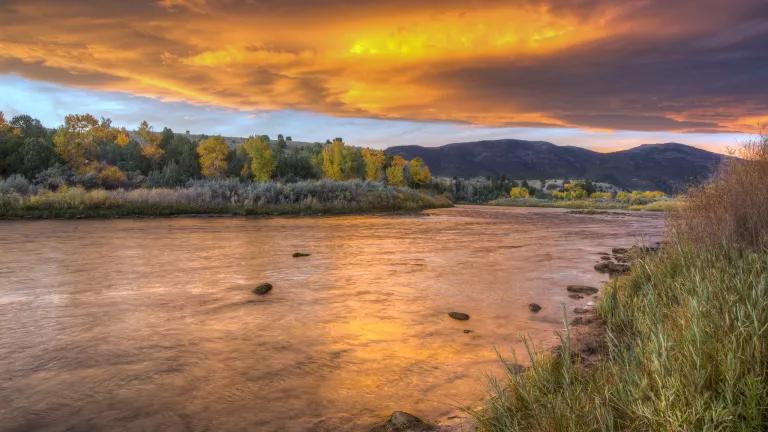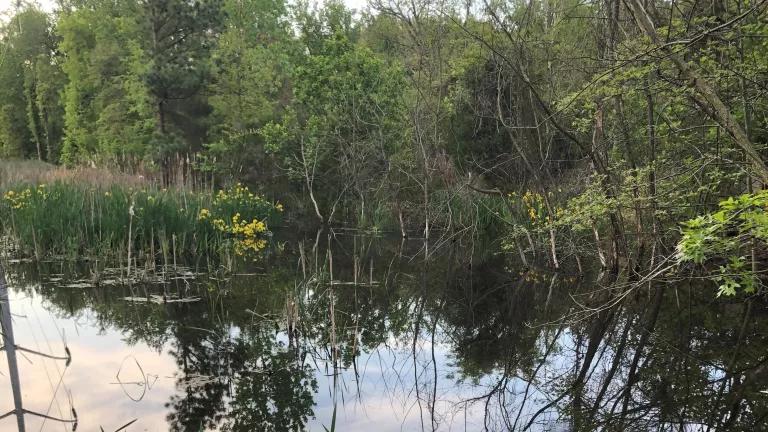
Wetland in Marshfield, Massachusetts
In 2022, there are dolphins swimming in the waters around New York City. The Potomac Riverkeeper Network has a plan to open the Potomac River in Washington D.C. for swimming for the first time in decades. Ohio’s Cuyahoga River, which famously caught fire multiple times in the ‘50s and ‘60s, has been declared safe for fishing. San Francisco Bay, which “just plain stank” in the late ‘60s and early ‘70s due to poorly-controlled sewage dumping and other industrial pollution, has seen a dramatic drop in pollution despite a large increase in population. In the 50 years since Congress passed the Clean Water Act, these and countless other places around the country have benefitted from the law’s strong protections against pollution.
That’s not to say the law has achieved its bold objective “to restore and maintain the chemical, physical, and biological integrity of the Nation’s waters.” Over 55% of rivers and streams and nearly 80% of bays and estuaries today aren’t meeting one or more standards that states have set at levels necessary to make sure they’re safe for things like fishing or swimming. Some 58% of rivers and streams have levels of phosphorus considered “poor”; nutrients –primarily phosphorus and nitrogen – fuel slimy algae outbreaks that can rob water bodies of oxygen when they die and decay and can produce toxins that are dangerous (even deadly!) to animals and people.
With the Clean Water Act’s 50th anniversary approaching in October, then, the country has a lot to celebrate about the law and a lot we still need it to accomplish. That’s why anybody who relies on clean water – that is, all of us! – should be paying close attention to a case at the Supreme Court, which threatens to undo the good that the Act has done and put the country on a road back towards its polluted past.
The case is called Sackett v. EPA, and it was brought to the Court by a couple who ran an Idaho excavation company, aided by a right-wing legal organization that has long fought against Clean Water Act (and many other environmental) requirements. At root, the case is about which kinds of streams, wetlands, and ponds the Clean Water Act protects from unregulated pollution. In this post, I’m going to share the arguments that have been made in the case and describe the threats that the case poses to water resources we all depend on.
The Sacketts destroyed wetlands on their property a stone’s throw from Priest Lake. The Idaho Conservation League told the Court that Priest Lake is known as the “Crown Jewel” of Idaho’s lakes, in part because “the 23,000-acre lake has earned a reputation as an international tourist destination for fishing, boating, canoeing, and all manner of outdoor sports.” As EPA’s brief points out, water flows belowground from a large wetland area known as the Kalispell Fen, through the Sackett property, and to Priest Lake. Two federal courts found that the Sackett wetlands and the Kalispell Fen have a significant impact on water quality in Priest Lake. That finding was enough, according to a prior Supreme Court decision, to trigger the Clean Water Act’s water quality safeguards (despite concerns that the Court’s previous decision left too many of the nation’s waters without protection from pollution).
But the Sacketts, their lawyers, and their polluting industry friends argue that the Supreme Court previously got it wrong and are hoping that the new justices on the Court will agree and adopt a radically limited view of what the law protects. Specifically, the Sacketts’ brief claims that the Clean Water Act, with few exceptions, only protects water bodies on which a boat will float and that either flow between states or are part of an interstate network of commerce. Many of the briefs (like the one from the Chamber of Commerce of the U.S.) supporting the Sacketts argue for a slight variation on their approach, pushing for an interpretation that would deny protections for streams that are periodically or ordinarily dry, as is the case for most of the streams in the Southwest, and for roughly half of the nation’s wetlands. That option would mimic a Trump administration regulation known to many as the “Dirty Water Rule,” a rule that two federal courts invalidated.
If the Sacketts’ view prevails, here are two examples of water bodies that’d likely be left without federal pollution-control protections. The first is a wetland in Marshfield, Massachusetts, where I grew up. Unfortunately, this picture is from December, but through much of the year, it is teeming with wildlife; it also is very close to several streams and wetlands in an area that leads right to the Atlantic Ocean. The second picture is a stream in my neighborhood in Arlington, Virginia, called Four Mile Run. As you can see, on the day I took this picture, it had been polluted with something not altogether natural. Because Four Mile Run isn’t navigable at this point, whoever is responsible for that pollution may not be able to be held to account under the approach pushed by the Sacketts and polluting industry, even though I regularly see kids in the water about half a mile downstream and even though Four Mile Run eventually flows to the Potomac River.

Four Mile Run, Arlington, Virginia
It is difficult to overstate the threat that these restrictions would pose to water quality in our rivers, lakes, and coastal areas, and to people who benefit from healthy, functioning water bodies. That includes flood-prone communities, which would be at greater risk if developers were free to bulldoze the wetlands that provide an estimated $1.2 to $2.9 trillion in flood protection nationwide. It also includes the roughly 117 million people in the U.S. that get drinking water from utilities whose supply is fed by non-navigable streams. And it includes the people who make more than 400 million beach visits every year. If the Clean Water Act cannot prevent the contamination and destruction of the water bodies that perform these vital functions, we’re all in trouble.
These and other concerns permeate the briefs supporting the protection of water bodies that significantly impact downstream water quality, including:
- A dozen scientific societies, which collectively represent more than 125,000 members and which told the Court that “The Clean Water Act’s mandate to restore and maintain the chemical, physical, and biological integrity of the Nation’s waters can only be met if the science regarding wetlands and streams is taken into account when determining which waters the Clean Water Act protects.”
- A variety of business interests, including craft brewers and the ecological restoration industry (such as companies that create and preserve wetlands to offset the impacts of projects that fill in wetlands in accordance with Clean Water Act permits), which explained that those two industry sectors are, respectively, responsible for “over $60 billion to the U.S. economy, and over 400,000 jobs,” and “$25 billion in annual output and 225,000 jobs to the United States economy.” These businesses explained that they depend on a robust suite of consistent protections for waterways.
- A total of 18 states and the District of Columbia, which supported a national baseline of federal protections because, among other things, nationwide standards guard against one state with lax regulations enabling pollution that harms its neighbor. As the brief for 17 states and D.C. put it, “federal minimum standards are required to protect against the risks of pollution and flooding posed by weaker or non-existent environmental standards or inadequate enforcement in upstream States.”
- Seventeen federally recognized Tribes, which explained that each of them “has a unique cultural, religious, and physical connection to water that is integral to who that Tribe is and how the Tribe’s people have lived their lives since time immemorial,” and which identified waters on their lands that would be at risk if the Court adopted the approach pushed by the Sacketts and their allies.
- Associations of community planners, wetland and floodplain managers, and drinking water providers, which put it starkly, saying the Sacketts’ approach “would exclude vast swaths of the Nation’s waters from coverage under the Act, including vulnerable waters that substantially benefit human welfare. The result would be a reduction in drinking water quality, more frequent severe floods, and barriers to development.”
- A group of 167 members of Congress, who cautioned: “Huge progress has been made in protecting this nation’s waters, but polluting and filling still threaten to destroy wetlands and other waters that provide valuable services to fisheries, wildlife, recreation, health, and drinking water. The resolution of this matter could have a profound impact on whether that progress is sustained.”
- Seven outdoor conservation and business organizations, which noted that “[h]ealthy waters sustain fish and other wildlife and support the $788 billion domestic outdoor recreation industry, including hunting, fishing, and water activities within the nation’s parks and other outdoor spaces.”
NRDC, with our partners at the Southern Environmental Law Center, filed a brief on behalf of 114 environmental and community organizations. We demonstrated that any fair reading of the Act’s language, of history, and of the Court’s own precedents would mean rejecting the Sacketts’ argument. Although you couldn’t be blamed if you looked at the Court’s recent decisions and worried about whether the rule of law will prevail, I am buoyed by the thought that the Court, just two years ago, decided another Clean Water Act case and rejected a Trump administration effort to create a loophole that would allow serious pollution sources to escape regulation, because doing so would undermine the core objective of the Act. Because that’s also the situation in this case, I have my fingers crossed. The Supreme Court will hold oral argument in the case on October 3 and will likely hand down a decision a few months later.
If this post has got you worried about the fate of the nation’s primary law protecting waterways, then I’ve succeeded. I would love to hear your stories – especially as we celebrate 50 years of the law – about water bodies you care about and how they could be affected if the Court decides to exclude most of the country’s wetlands and small streams from protections against pollution and destruction. Seriously! I’m at jdevine@nrdc.org. Please drop me a line.




